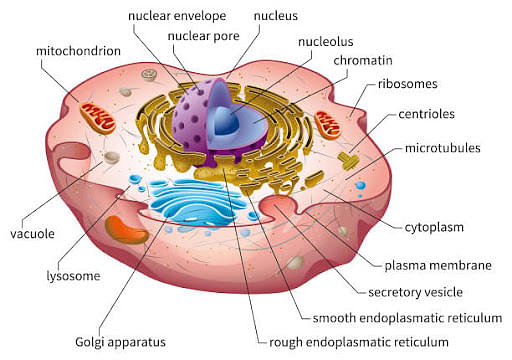Match the following and choose the correct combination from the options given
- a - 1, b - 2, c - 3, d - 4.
- a - 4, b - 3, c - 2, d - 1.
- a -1 , b - 3, c - 2 , d - 4.
- a - 4, b - 2, c - 3 . d - 1.
The Correct Option is B
Approach Solution - 1
Approach Solution -2
Ans. Cartilages are non-vascular connective tissue that supports the other tissues throughout the body. It provides protection and supports the structure of the body. It is primarily made up of water and exists in the nose, airway, joints, ear, and intervertebral disc of the spine. Chondrocytes are specialized cells that produce a mixture of collagen, proteoglycans, and other non-collagen proteins that make up the cartilage.
Cartilage is referred to as the connective tissue that makes up the skeleton of the mammalian embryos before the formation of the bone begins, and persisting in the part of the human skeleton in adulthood. It is the only component of the skeleton that is found in some of the certain primitive vertebrates, including sharks and lampreys. Cartilage is formed of a dense network of collagen fibres embedded in a firm gelatinous ground substance.
- Cartilages provide support to the embryo and act as a cushion to the bone
- Cartilages promote rapid growth and development of the musculoskeletal system
- Cartilages initiate smooth facial movement and provide support to the structure in the external ear, septum, and tip of the nose.
- Cartilages prevent damage and abrasion in the places where two bones meet each other, thus acting as a shock absorber.
- The flexibility of the joints is because of cartilage.
- The trachea is surrounded by rings of cartilages to prevent damage and collapse
- The upward and outward movement of the rib cage during inhalation is due to the cartilages present at the end of the rib
- Cartilages help in the bone repair in embryo
Top Questions on Cell: the unit of life
- Which organelle is primarily responsible for producing ATP in a cell?
- MHT CET - 2025
- Biology
- Cell: the unit of life
- Which organelle in a eukaryotic cell is primarily responsible for synthesizing proteins destined for secretion?
- MHT CET - 2025
- Biology
- Cell: the unit of life
- Which of the following organisms or organelles contain 70S ribosomes?
- MHT CET - 2025
- Biology
- Cell: the unit of life
- Which term is used for cells performing similar functions and cells collecting intracellular material?
- AIIMS - 2024
- Biology
- Cell: the unit of life
- What is the movement of cytoplasm within a cell called?
- MHT CET - 2024
- Biology
- Cell: the unit of life
Questions Asked in KEAM exam
- Given the function \( h(x) = f(g(x)) \), where \( f(x) = f'(x) = 3 \), and \( g(x) = 9 \), find \( g'(3) \), \( f'(3) \), and \( h'(3) \).
- KEAM - 2025
- Functions
- If $ \mu_s $ and $ \mu_k $ are static and kinetic friction, then:
- KEAM - 2025
- Friction
- Coefficient of friction is the ratio of?
- KEAM - 2025
- Friction
- When blue light is incident on metal surface, photoelectrons are emitted. When green light is incident, no photoelectrons are emitted. What is the number of photoelectrons emitted when yellow light is incident?
- KEAM - 2025
- simple harmonic motion
- Electric field lines around a positive charge are directed:
- KEAM - 2025
- Electric Field
Concepts Used:
Cell: The Unit of Life
- A cell is derived as the functional and structural unit of life. Every cell is surrounded by a cell membrane that dissects the external and internal environments of the cell. The interior environment of a cell is called the cytoplasm.
- It carries cellular machinery and structural elements. The nucleus is present in the center of the cell, which includes all the hereditary information of an organism. Some of the molecules present in the cell are protein, carbohydrates, starch, and sugar.
Read More: Fundamental Unit of Life: Cell
Parts of Cell:
The different parts of a cell and their functions are as follows:
- Cell Membrane
- Cell Wall
- Nucleus
- Cytoplasm
